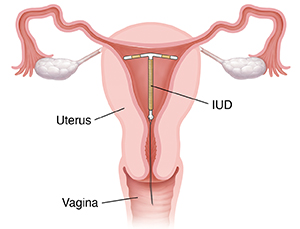The IUD (intrauterine device) is small, flexible, and T-shaped. A trained healthcare provider places it in the uterus. The IUD is one of the most effective birth control methods. It's also reversible. This means it can be removed at any time by a trained healthcare provider. New IUDs are safe and don't have the risks of older types of IUDs.
Pregnancy rates
Talk to your healthcare provider about the effectiveness of this birth control method.
Types of IUDs
IUD insertion is done in the healthcare provider’s office. Two types of IUDs are available:
-
The copper IUD releases a small amount of copper into the uterus. The copper makes it harder for sperm to reach the egg. The device works for at least 10 years.
-
The progestin IUD releases a hormone called progestin. It causes changes in the uterus to help prevent pregnancy. The device works for 3 to 8 years, depending on which device is chosen. It may be recommended for women who have anemia or heavy and painful periods.
IUDs have thin strings that hang from the opening of the uterus into the vagina. This lets you check that the IUD stays in place.
Things to know about IUDs
-
IUDs can be used by women who have never been pregnant or by women with a history of sexually transmitted infections (STIs) or tubal pregnancy.
-
It won't move from the uterus to any other part of the body.
-
There is a slight risk of the device coming out of the vagina (expulsion).
-
It may not work in women who have an abnormally shaped uterus.
-
A copper IUD may cause heavier periods and cramping.
-
A progestin IUD may cause light periods or no periods at all (irregular bleeding or spotting is possible and normal during the first 3 to 6 months).
-
If you get a sexually transmitted infection with an IUD in place, symptoms may be more severe.
What to report to your healthcare provider
Be sure your healthcare provider knows if you have:
-
A sexually transmitted infection (STI) or possible STI
-
Liver problems
-
Blood clots (for progestin IUD only)
-
Breast cancer or a history of breast cancer (progestin IUD only)
Featured in


